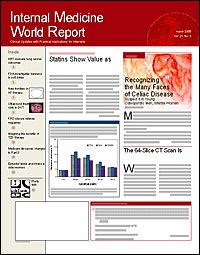Publication
Article
Internal Medicine World Report
Effective Approach to Chronic Pain Treatment in Primary Care
Author(s):
SAN DIEGO?Prescribing opioids and other chronic pain killers is problematic for many primary care physicians, who worry about addiction and drug abuse as well as possible legal consequences to themselves. Now some pain medicine experts suggest that primary care physicians use a new approach that involves risk assessment by a biopsychosocial model that includes past and present aberrant behaviors.
This model, said Howard Heit, MD, of Georgetown University, Washington, DC, at the 22nd Annual Meeting of the American Academy of Pain Medicine, can reduce patient stigma and minimize physician risk, while improving overall care in this challenging patient population.
"You have to treat chronic pain in a biopsychosocial setting. The drug is just one piece of the pie. You also have to address depression, anxiety, bipolar disease, nonrestorative sleep, physical abuse, and even past history of sexual abuse.... Just prescribing medications will rarely allow you to reach the goal of improving patients' function and lowering their pain," Dr Heit told IMWR.
He conducted a workshop at the meeting called "The Truth About Opioid Pain Management" and said that effective management of chronic pain poses many challenges to physicians. Although an estimated 8% to 10% of the US adult population has an addiction disorder, primary care physicians, who see many of these patients, are given little training in either pain or addiction medicine, he said.
Many physicians are unfamiliar with terms such as "chemical coping" and do not understand the difference be?tween addiction and physical dependence. The behavior of those who are using chemical coping resembles that of ad?diction. Physical dependence, which is characteristic of those using drugs to relieve chronic pain, is defined as a state of adaptation that is manifested by a drug class?specific withdrawal syndrome, which can be produced by abrupt cessation, rapid dose reduction, a decreasing serum drug level, and/or administration of an antagonist. It is a natural and expected consequence of chronic exposure to any agonist class of drug, such as opioids or certain antidepressants.
Addiction is a chronic, neurobiologic disease. Genetic, psychosocial, and environmental factors influence its development and manifestations. According to a consensus statement from the American Pain Society and the American Society of Addiction Medicine, addiction is characterized by >=1 of the following manifestations:
? Impaired control over drug use
? Compulsive use
? Continued use despite harm
? Craving.
Dr Heit said physicians are increasingly worried about prescribing opioids or other controlled substances because of the possible legal ramifications. Thus, the use of opioids, which should play a pivotal role in pain treatment, is limited.
"The problem is getting worse," Dr Heit said. "Our fear of abuse, diversion, and addiction is affecting the quality of care. Those problems only happen in a small percentage of patients. A great majority of patients are not being treated with medications that could improve their quality of life. The undertreatment of pain is costing society billions of dollars in lost productivity and [taking] an immeasurable toll on quality of life. In fact, over $100 billion a year is lost because people are so undertreated for pain."
Surprisingly, few primary care physicians are fully aware of their state or federal regulations, according to Dr Heit. "That is a problem, because if you don't know the rules of the game, you aren't going to play it well."
Dr Heit, who is an internist, knows the situation firsthand. He was critically injured in a car accident that left him in chronic pain. Because he felt that his own chronic pain care was so abysmal, he decided to retrain in pain and addiction medicine. He is now certified in addiction medicine and is a chronic pain specialist.
When treating chronic pain, he says it is important to set goals with 3 basic tenets: decreasing pain, increasing function, and using medications with acceptable side effects.?J.S.






